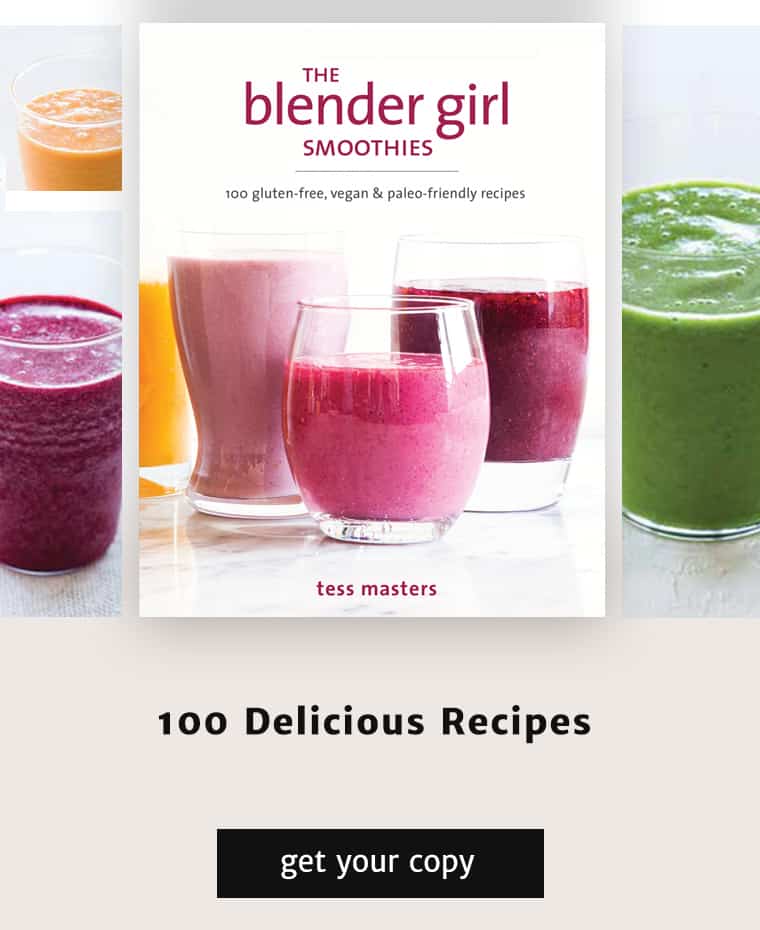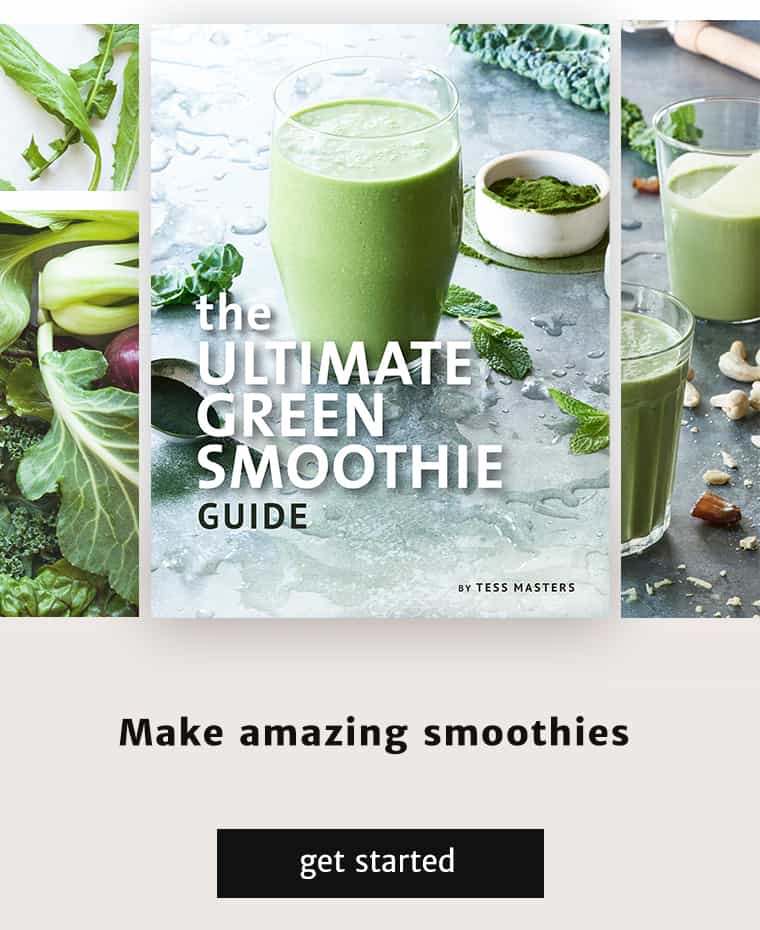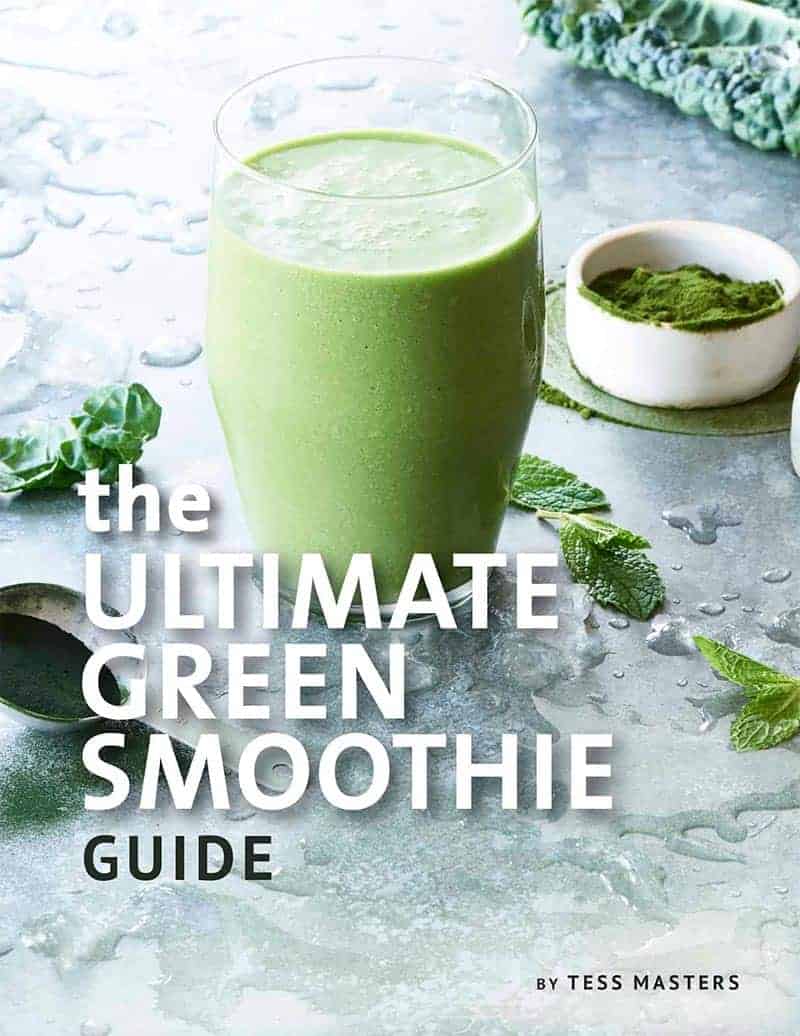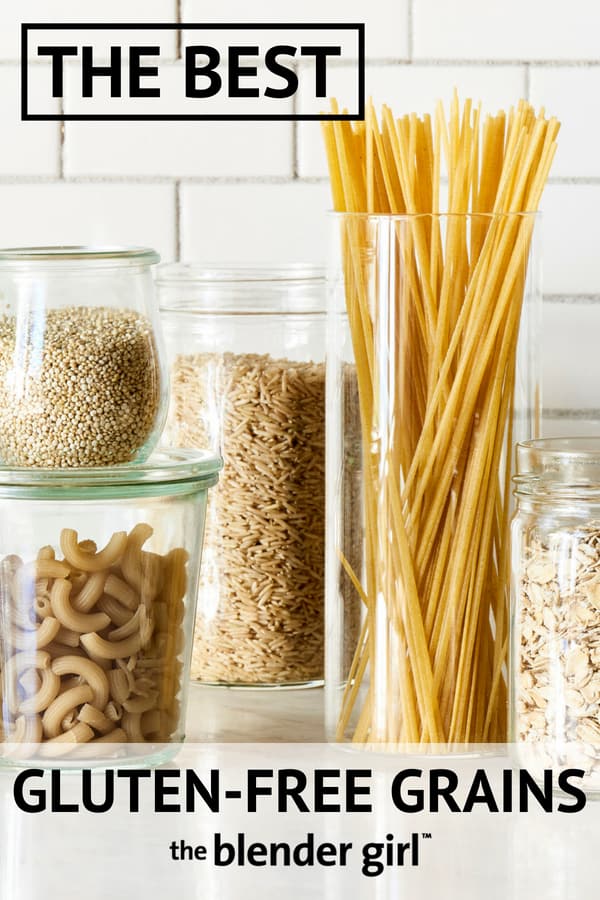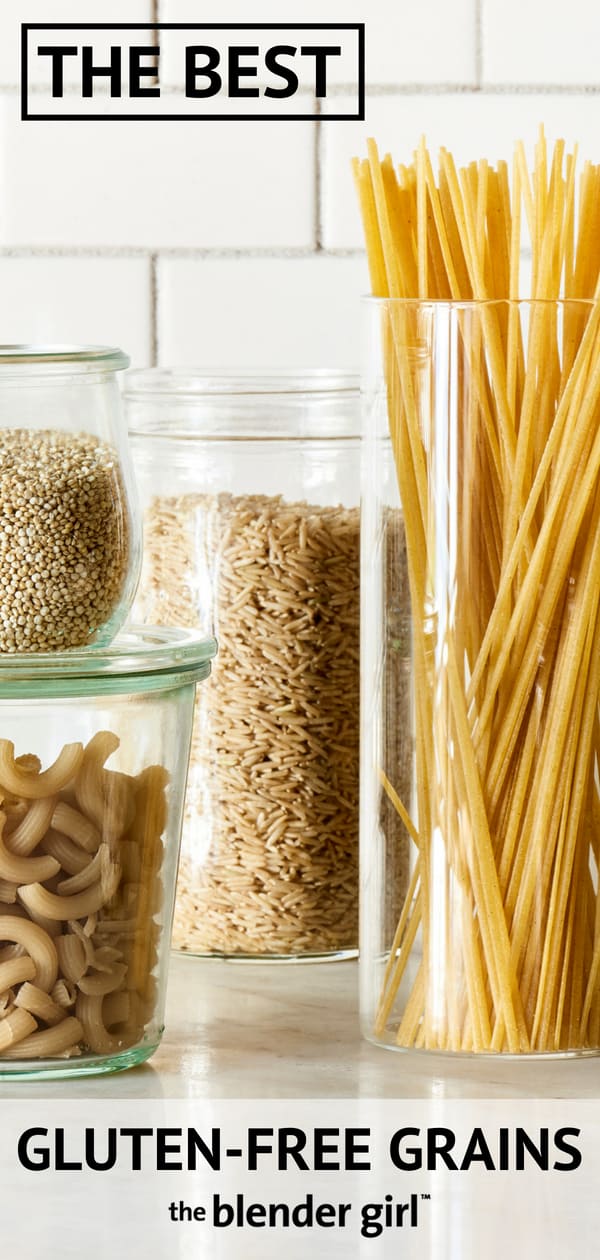Gluten-Free Grains and Pasta
Tips for selecting, storing, cooking, and serving gluten-free grains and pasta to create delicious healthy recipes.
Gluten-Free Grains and Pasta
There are a variety of gluten-free grains and pastas that are easy to cook for delicious, healthy vegan meals.
Here are my go-to gluten-free grains, and tips for selecting, storing, cooking, and serving them to create delicious, healthy gluten-free, plant-based dishes.
Table of Contents
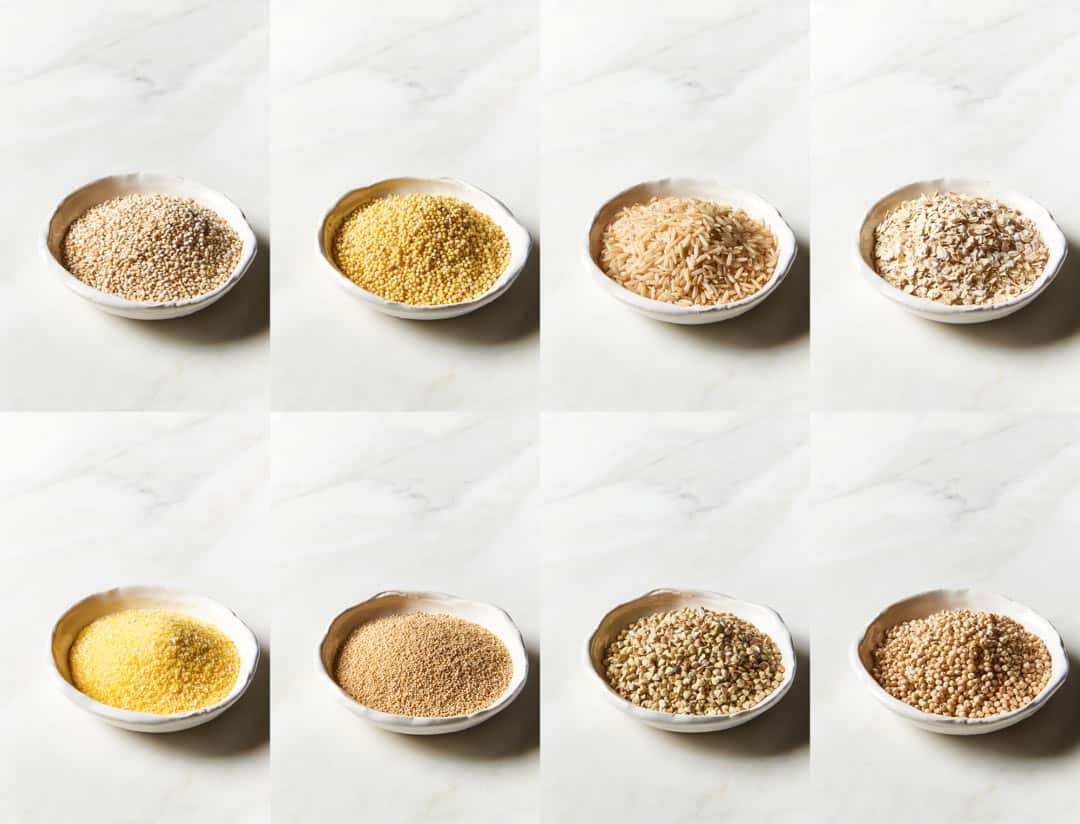
How To Store Gluten-Free Grains
Choose organic whole gluten-free grains wherever possible, and purchase from a health food store, grocer, or online retailer with a high turnover to ensure maximum freshness.
Store your gluten-free grains in sealed glass jars in a cool dry pantry or the fridge. Check the use-by date, and consume in good time.
Soaking Gluten-Free Grains
I recommend soaking all grains to neutralize enzyme inhibitors and activate full nutrient potential. You can read more about the nutritional and culinary benefits of soaking gluten-free grains here.
Cooking Gluten-Free Grains
The variety of the grain will determine the best liquid-to-grain ratio for cooking. It is typically 1 cup of grain to 2 cups of filtered water or vegetable broth for unsoaked grains, and 1 cup of grain to 1 1/2 cups of liquid for grains that have been soaked.
Cooking times will vary.Your cooked grain will vary slightly, depending on the method of cooking, the type of liquid being used, and the quality of the grain. I have recommended cooking times, and liquid-to-grain ratios to make it easier to work with these grains.
I use a traditional rice cooker to cook my grains. If you stick to the grain to liquid ratios specified, they should turn out light and fluffy every time.
I like my grains cooked al dente with a tiny bit of bite. I don’t like sticky or gluggy grains. If you prefer softer grains add more liquid as desired.
How To Flavor Gluten-Free Grains
For savory dishes, cook your grains in vegetable broth. To boost the flavor and medicinal power of your grains even further add in some some minced fresh garlic, grated fresh ginger or turmeric, or dried spices. Adding some sea vegetables mineralizes the grains for better digestion.
Then, after cooking, toss your grains with some fresh herbs such as flat-leaf parsley, cilantro, mint, basil, thyme, rosemary, chives, or dill.
How To Serve Gluten-Free Grains
Use your gluten-free grains as you would regular grains:
For savory dishes: served with stir-fries, stews, curries, and steamed or roasted vegetables. And to enjoy with soup in place of a bread roll use an ice cream scoop to top your soup bowl with a grain ball.
For sweet dishes: gluten-free grains make fantastic creamy porridge-like cereals; and are wonderful for use in puddings and desserts. I love quinoa, millet or amaranth porridge cooked in coconut milk or almond milk, and sweetened with stevia, maple syrup or dates!
Grain Milks: Brown rice, quinoa, millet, and oats make fantastic plant-based milks.
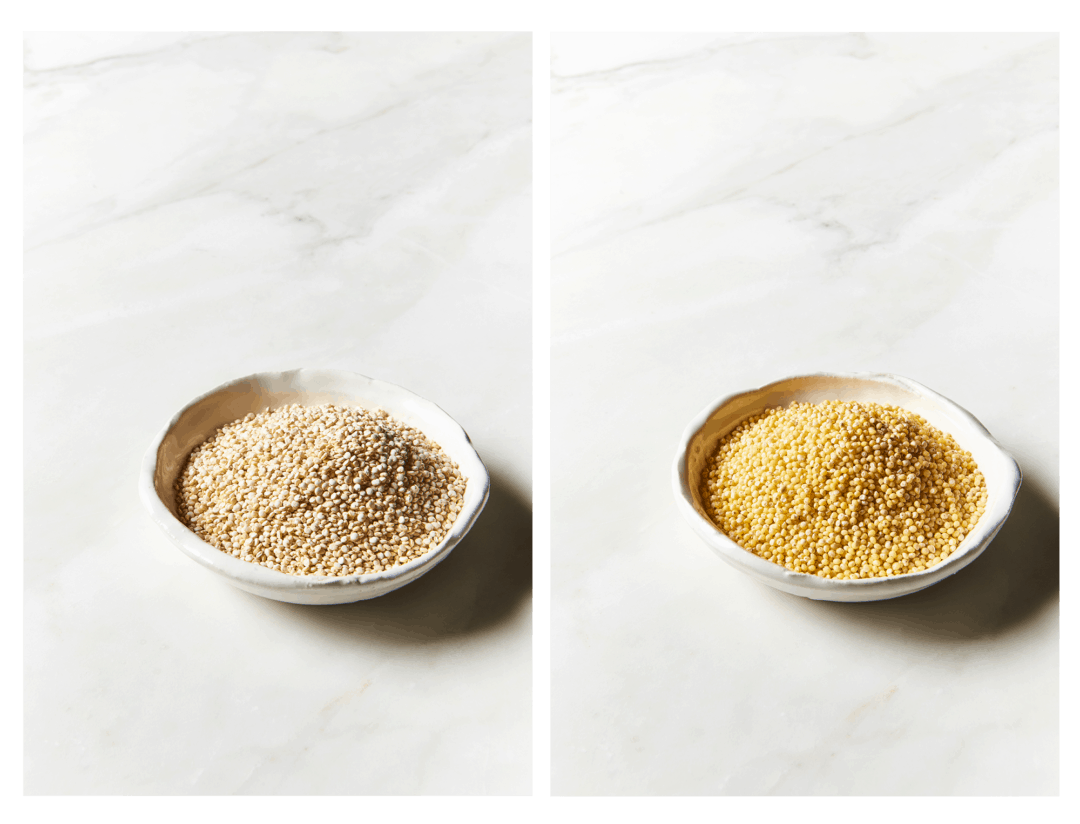
Quinoa
Quinoa (pronounced ‘keen-wah’) is gluten-free and vegan, and one of the most complete and versatile whole foods available. It is one of my go-to grains.
Quinoa is a wonderful alkaline-forming, “grain-like” food. Botanically, quinoa is a seed related to spinach, but we enjoy it like a grain. The Incas held this crop to be sacred. They referred to quinoa as the “mother of all grains”. It was so revered for keeping the army strong that the emperor would sow the first seeds of the season with golden implements.
The Nutritional Benefits of Quinoa
Quinoa is rich in plant-based protein. It contains all nine essential amino acids required for health. It also contains vital enzymes, vitamins and minerals, antioxidants, and fiber.
Quinoa is an excellent source of dietary fiber and phosphorus; is high in iron and magnesium, and doesn’t feed yeast, fungus or bacteria in the body.
So, quinoa is one of the four gluten-free “grains” suitable for those following The Body Ecology Diet. According to Donna Gates, studies have shown that quinoa acts as a “prebiotic” that encourages the proliferation of beneficial bacteria in the intestines.
How To Store Quinoa
Quinoa has a relatively high fat content, and should always be stored in a sealed glass container in a cool, dry pantry. Quinoa grains should be used with 12 months.
Varieties Of Quinoa
There are many varieties and colors of quinoa, ranging from white, ivory, and pink to red, brown and black.
White or ivory quinoa, sometimes referred to as “royal quinoa” is the most widely available. You can also find red, black, and tri-color (mixed grain) quinoa at health food stores and specialty retailers.
The white quinoa is a little sweeter, and is the variety most commonly used. This is the kind I use the most in salads and pilafs. The red variety is a little fruitier and adds a beautiful color to green dishes.
How To Soak Quinoa
Always soak quinoa before cooking in order to remove the oxalic acid, saponins, and other anti-nutrients. Learn more about soaking quinoa here. Toasting quinoa in a skillet after soaking enhances the flavor, and makes a nice change.
How To Sprout Quinoa
Soak 1/3 cup of seeds in jar of filtered water for about 4 hours, and then rinse twice a day for 4 days until they sprout to about an inch long. Then put them on a sunny windowsill and allow them to green. Quinoa sprouts are fantastic in salads or tossed with extra-virgin olive oil, salt, and pepper.
How To Cook Quinoa
For unsoaked quinoa: Use 1 cup of quinoa to 2 cups of filtered water or vegetable broth.
For soaked quinoa, use 1 cup of quinoa to 1 1/2 cups of liquid.
To cook on the stove top: Bring 2 cups of water or broth to the boil, and add in one cup of quinoa. Cover, and simmer for about 20 minutes. Add sea vegetables and spices while cooking or stir through fresh herbs after cooking.
To cook in a rice cooker, place the drained quinoa in the machine and hit the rice setting.
How To Serve Cooked Quinoa
Quinoa is easy to digest, has a light fluffy texture with a slight crunch, ands mild, nutty flavor.
Use quinoa as a protein-rich substitute for rice and couscous in pilafs and stuffings.
Serve quinoa with stir-fries, curries, and stews.
Use quinoa as a gluten-free substitute for cracked wheat in tabouli and other salads.
Use an ice cream scoop to make a quinoa ball to serve on top soups and stews in place of bread.
Make quinoa porridge. Quinoa makes a wonderful high protein alternative for oatmeal.
Grind uncooked quinoa grains in a spice grinder or coffee grinder to make quinoa flour for gluten-free breads, muffins, cakes, and other baked goods.
Millet
Along with quinoa, millet is one of my go-to “grains”. Not strictly a grain, but rather, a “grain-like” seed, millet is one of the oldest foods known to man. Millet was the grain of choice in China before rice became dominant. Today, it is an important grain in Africa, China, Japan, India and Egypt; and sustains about one third of the world’s population.
Millet rose to prominence in health circles famous for being the staple grain of the Himalayan “Hunzas” who are renowned for their superior health and longevity.
In the West, millet is primarily cultivated and used for cattle and bird feed. But thankfully, it’s gaining momentum in health circles, and showing up on more restaurant menus.
The Health Benefits Of Millet
Millet is one of the most nutrient-dense grains available. Millet is about 15% protein – rich in essential amino acids. It also contains a good amount of dietary fiber and B Vitamins, as well as iron, magnesium, potassium and phosphorus.
Millet is one of the least allergenic, and easily digestible gluten-free grains, and is strengthening for the digestive system.
This wonder food is also alkaline-forming and does not feed yeast and fungus. Like quinoa, millet is one of the four grains suitable for those following The Body Ecology Diet. Millet acts as a prebiotic, and feeds beneficial bacteria in the body. It also hydrates the colon, assisting with healthy elimination, and boosts serotonin levels, fat metabolism, and tissue repair.
Varieties Of Millet
For human consumption, the indigestible outer hull must be removed, leaving the germ intact. Hulling millet does not alter the nutrient profile.
There are a lot of varieties of millet. But hulled pearl millet is the variety typically available.
How To Store Millet
Store millet in a sealed glass container in a cool, dry pantry. Millet has a relatively long shelf life and can be stored for up to two years.
How To Soak Millet
I recommend soaking millet before cooking to neutralize enzyme inhibitors. For those with thyroid conditions, soaking millet is particularly important to neutralize the goiterogenic thyroid inhibitors. Those with thyroid conditions should consume millet in small quantities.
Soak millet for 8 hours, and then drain and rinse. Read more about soaking millet here.
You could also roast the seeds in a skillet after soaking to heighten the flavor before cooking.
How To Cook Millet
For unsoaked millet use 1 cup of millet to 2 cups of filtered water or vegetable broth.
For soaked and drained millet, cook with 1 cup of soaked millet to 1 1/2 cups of water of broth.
To cook on the stove top: Bring liquid to the boil, add millet, and simmer covered for about 20 minutes. Then allow the cooked millet to steam for 5 minutes more.
To cook in a rice cooker, add the millet and liquid and select the rice setting.
Cook with garlic, ginger, turmeric, or ground spices or stir through fresh herbs after cooking.
How To Serve Millet
Millet is fantastic for savory and sweet dishes. These tiny little yellow beads have a delicious slightly sweet, nutty flavor.
Use millet as a protein-rich substitute for rice and couscous in pilafs and stuffings.
Serve millet with stir-fries, curries, and stews.
Use cooked millet as a gluten-free substitute for cracked wheat in tabouli and other salads.
Use an ice cream scoop to make a cooked millet ball to serve on top soups and stews in place of bread.
Make millet porridge. Millet makes a wonderful high protein alternative for oatmeal. Cook with coconut or almond milk and stir through some natural sweetener and coconut oil for a delicious treat.
Make Cauliflower Millet Mash. This dish is a fantastic creamy alternative to mashed potatoes.
Grind uncooked millet grains in a spice grinder or coffee grinder to make millet flour for gluten-free breads, muffins, cakes, and other baked goods.
Make popcorn: Millet can be popped with coconut oil for a healthy movie snack.
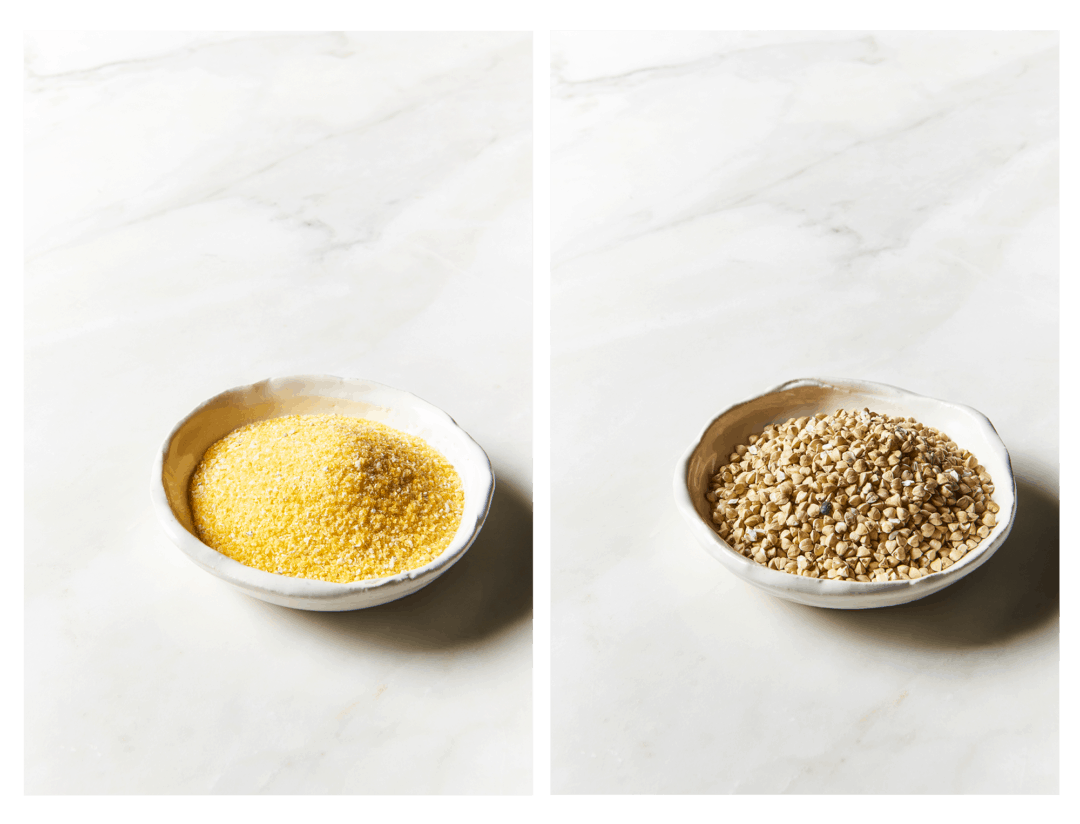
Buckwheat
Despite the confusing name, buckwheat is not related to wheat, and is gluten free. Like quinoa and millet, buckwheat is not botanically a grain. It is a fruit seed, related to rhubarb and sorrel.
The Health Benefits Of Buckwheat
Buckwheat contains highly digestible protein and is rich in essential and non essential amino acids. In fact, buckwheat a superior source of protein in comparison to millet.
Buckwheat is rich in alkaline-forming minerals such as calcium, iron, magnesium, manganese, zinc and copper. It also contains powerful antioxidants such as quercetin, and rutin, a flavanoid that supports the integrity of blood vessels. So, buckwheat is known for promoting heart health and regulating cholesterol levels.
The soluble fiber in buckwheat is like a sponge, that slows down the absorption of sugars, and aids with healthy digestion and assimilation.
However, buckwheat is highly mucoid and acid forming; whereas quinoa and millet are alkaline forming. In order to make buckwheat less acid forming, use a bit of Celtic sea salt while cooking.
Varieties Of Buckwheat
Buckwheat must be milled in order to remove the indigestible outer hull, and these groats are sold unroasted or roasted (kasha).
Buckwheat has a tan-pink or brown color, and has a triangular shape.
Roasted buckwheat has a nutty flavor, whereas the unroasted variety is a lot more subtle.
How To Store Buckwheat
Store in a sealed glass container in a cool, dry pantry. Buckwheat should be used with 12 months.
How To Soak Buckwheat
Soak to neutralize the enzyme inhibitors and to activate the full nutrient potential.
Learn more about soaking buckwheat here.
Toasting buckwheat in a skillet after soaking enhances the flavor, and makes a nice change.
How To Cook Buckwheat
Buckwheat groats are widely used in raw dishes, and can be soaked and consumed raw.
To Cook:
For unsoaked buckwheat use 1 cup of millet to 2 cups of filtered water or vegetable broth.
For soaked and drained buckwheat, cook with 1 cup of soaked buckwheat to 1 1/2 cups of water of broth.
To cook on the stove top: Bring liquid to the boil, add the buckwheat, and simmer covered for about 20 minutes.
To cook in a rice cooker, add the buckwheat and liquid and select the rice setting.
Cook with garlic, ginger, turmeric, or ground spices or stir through fresh herbs after cooking.
How To Serve Buckwheat
I use buckwheat as a variation from quinoa and millet with steamed vegetables, stir-fries and curries.
But my favorite way to eat buckwheat is to cook it, stir through some herbs and greens, and pour it into an oiled baking dish. Allow it to set in the fridge, and then cut into triangles and fry like polenta. Top with your favorite sauce.
You can also make sweet treats by frying up cooked buckwheat with coconut oil, and then topping with your favorite natural sweetener.
Buckwheat makes a fantastic porridge-like cereal that is really comforting. Top with some stevia, maple syrup, or other sweetener. Try it with coconut milk.
Buckwheat sprouts are a fantastic addition to salads and stir fries.
Buckwheat flour is widely used to make delicious nutritious gluten-free pancakes and baked goods.
Polenta / Cornmeal
Polenta or cornmeal (ground maize) is available in course and fine textures.
The Health Benefits Of Cornmeal
Cornmeal contains some protein and iron, and small amounts of minerals. But cornmeal is mainly carbohydrate. For those with candida issues, that spells trouble, as cornmeal feeds yeast and fungus and is difficult to digest. But the good news is that it is low in saturated fat and sodium. I tell myself that as I grab for the polenta instead of the quinoa! I reserve polenta for a treat, and have throw it in here for culinary pleasure.
How To Store Cornmeal
Always purchase organic cornmeal, store in a sealed glass jar in a cook dark place, and consume in good time.
How To Cook Cornmeal
Polenta is incredibly easy to prepare by bringing some vegetable broth or filtered water to the boil and whisking in some cornmeal. It gets rich and creamy, ready to take on the flavor of whatever you add to it.
Plain polenta is really bland and unpalatable. So, I always cook cornmeal in vegetable broth, garlic, and spices to boot up the flavor.
I generally use a ratio of one parts cornmeal to three parts vegetable broth for course polenta. Bring the broth to a boil, reduce the heat to medium-high, and then whisk in the cornmeal. I find polenta has a real propensity to stick to the bottom of the saucepan, and requires constant stirring over the course of about an hour. I use a flame deflector in order to minimize sticking and burning.
You can purchase quick cooking polenta, which only takes a few minutes. But this convenience means your grain is processed more heavily. You can also purchase cooked polenta that has been rolled like sausage meat. Just cut, fry up, and top with your favorite sauce.
Once cooked, stir through some nutritional yeast, olive oil or vegan butter, onion powder, garlic powder, salt, and pepper to taste, and then, while still hot, stir in some chiffonaded spinach, chard, or kale. Set in a baking dish, and then frying up triangles, sticks, patties and balls with some coconut oil, and topping with a rich velvety tomato sauce or curry sauce.
How To Serve Cornmeal
Serve boiled, fried, or baked polenta with sauces and vegetables for a delicious appetizer or meal. Cook polenta and make a lasagna-style bake by adding in vegetables, herbs, and spices. Fine cornmeal (flour) is often added to gluten-free baked goods.
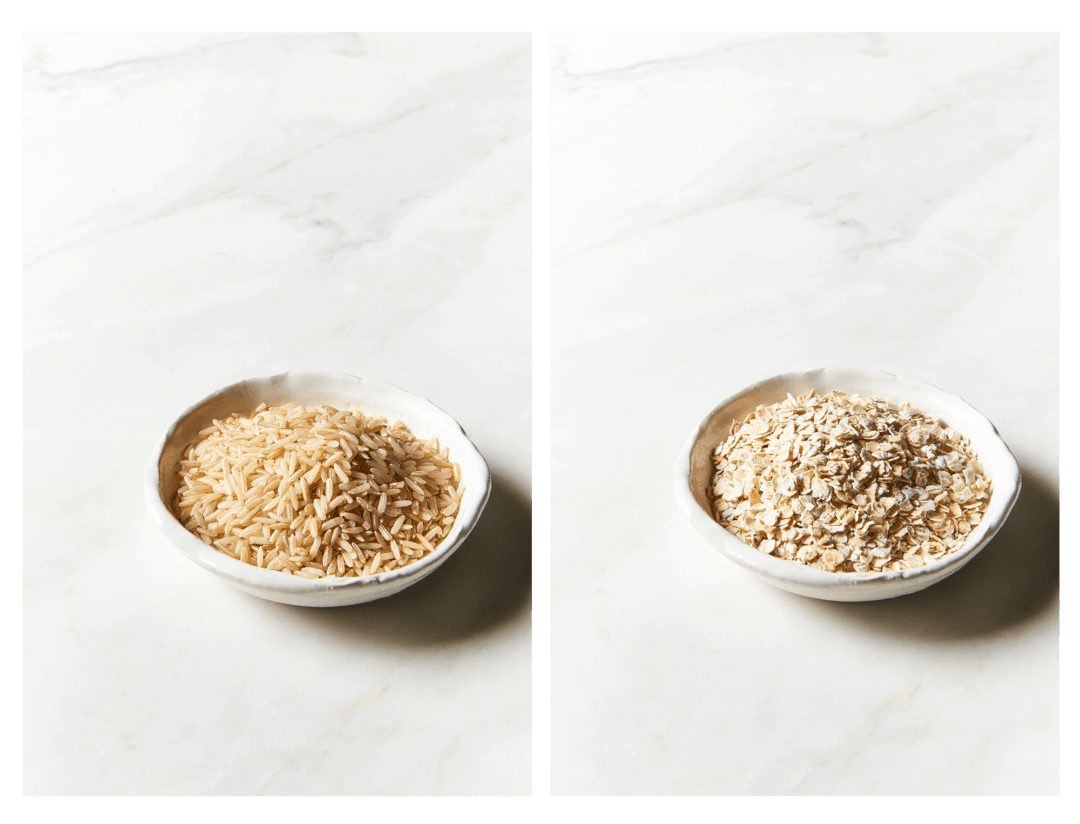
Amaranth
Turn over a packet of amaranth, and you’ll be amazed at the nutritional profile. These tiny seeds pack a powerful nutritional punch!
Amaranth is a wonderful gluten-free, alkaline-forming, “grain-like” seed that is rich in protein (about 16%). Amaranth contains high amounts of lysine and methionine, two essential amino acids that are lacking in a lot of other grains. This wonder seed also contains a good amount of iron and fiber.
The ancient Aztecs relied heavily on amaranth, and it has been cultivated for over 8,000 years.
Amaranth is not really a mainstream grain yet, and is mainly found at health food stores.
How To Store Amaranth
Store amaranth in a sealed glass container in a cool, dry pantry, and consume within 12 months.
How To Soak Amaranth
Soak amaranth before cooking in order to neutralize enzyme inhibitors and activate the full nutrient potential. Learn more about soaking amaranth here.
Toasting amaranth in a skillet after soaking enhances the flavor, and makes a nice change.
How To Cook Amaranth
For unsoaked amaranth: Use 1 cup of amaranth to 2 cups of filtered water or vegetable broth.
For soaked amaranth, use 1 cup of amaranth to 1 1/2 cups of liquid.
To cook on the stove top: Bring 2 cups of water or broth to the boil, and add in 1 cup of amaranth. Cover, and simmer for about 20 minutes. Add sea vegetables and spices while cooking or stir through fresh herbs after cooking.
To cook in a rice cooker, place the drained amaranth in the machine and hit the rice setting.
How To Serve Amaranth
Use cooked amaranth as a protein-rich substitute for rice and couscous in pilafs and stuffings.
Serve cooked amaranth with stir-fries, curries, and stews.
Use cooked amaranth as a gluten-free substitute for cracked wheat in tabouli and other salads.
Use an ice cream scoop to make a cooked amaranth ball to serve on top soups and stews in place of bread.
Cook amaranth with coconut or almond milk to make amaranth porridge.
Raw amaranth can be popped in the same way as popcorn. Cook with some coconut oil and you have a quick, healthy, protein-rich movie snack.
Add puffed amaranth to fortify homemade power bars and cereals.
Sprouted amaranth seeds are fantastic in salads.
Amaranth flour (ground raw seeds) is a wonderful nutrient-rich flour for gluten-free baking.

Brown Rice
There are over 8,000 different varieties of rice, and rice sustains over half of the world’s population. No wonder in some Asian languages, “to eat” literally translates “to eat rice”.
I prefer brown rice because it is the most nutritionally dense variety that has undergone the least amount of processing.
The Health Benefits Of Brown Rice
Brown rice is the whole grain, that has been hulled, removing the inedible outer layer, leaving the nutrient-rich bran and germ available.
Whole-grain brown rice contains essential nutrients such as B vitamins, manganese, selenium, magnesium, iron, and phosphorus, as well as dietary fiber and essential fatty acids.
The dietary fiber in brown rice can help reduce the risk of colon and breast cancer; assist with weight loss and metabolic disorders; regulate blood sugar levels and assist with diabetes; and lower cholesterol and protect against heart disease and strokes.
Conversely, white rice has been milled; and in the process of refining and polishing, the bran and germ has been removed, along with all of the valuable nutrients. White rice is delicious, but it is just empty starchy calories with no nutritional benefit. In fact, legislation in some countries dictates that white rice be enriched and fortified with some of these nutrients in order to meet the nutritional standards for human consumption.
I generally opt for quinoa and millet over brown rice, due to the high carbohydrate profile that feeds yeast and fungus, particular in people with really compromised immune systems.
Quinoa and millet are also alkaline-forming, whereas rice is more acid-forming. alkaline than brown rice.
However, for those living with food allergies, brown rice is considered a low allergy food, and is a great option.
How To Store Brown Rice
Some research suggests that non-organic U.S long grain rice may contain up to 5 times the arsenic than rice produced in India, Bangladesh or Europe. So purchase organic wherever possible.
Always purchase organic brown rice from stores with a high turn over to ensure maximum freshness, and take note of the use-by date.
Due to the natural oils contained in the germ of brown rice, it is susceptible to rancidity. So always store in a sealed glass container in a cool, dry pantry, and consume in good time.
How To Soak Brown Rice
Soak brown rice to neutralize the enzyme inhibitors to improve digestibility. Learn more about soaking brown rice here.
I will often toast brown rice in the skillet to enhance the flavor and make it more digestible before cooking.
Soaking has other added benefits. When you soak brown rice it becomes more light and fluffy, making it more appealing to those people who are opposed to the more gritty texture. Soaking is a great way to introduce children or reluctant adults to brown rice.
How To Cook Brown Rice
For unsoaked quinoa: Use 1 cup of quinoa to 2 cups of filtered water or vegetable broth.
For soaked quinoa, use 1 cup of quinoa to 1 1/2 cups of liquid.
To cook on the stove top: Bring 2 cups of water or broth to the boil, and add in one cup of quinoa. Cover, and simmer for about 20 minutes. Add sea vegetables and spices while cooking or stir through fresh herbs after cooking.
To cook in a rice cooker, place the drained quinoa in the machine and hit the rice setting.
How To Serve Brown Rice
Brown rice is incredibly versatile and is a glorious blank canvas for spicy, sweet, tangy, fruity or salty. It is hard to pass up a delectable rice pudding, rice pilaf, rice balls or rice salad. But you can make brown rice sushi, wraps or frittatas. Or have your tried making a pizza base by pressing cooked day-old brown rice into a pizza tray? Yum!
Brown Rice Flakes
Toasted rolled rice flakes are a fantastic gluten-free substitute for traditional oats if you have a serious gluten sensitivity and don’t want to fork out the money for safe gluten-free oats.
Brown rice flakes have a similar texture to conventional oats, but are a little bit firmer.
You can soak brown rice flakes in filtered water or milk in order to soften them.
Rice flakes make fantastic gluten-free porridge and puddings; and are wonderful for use in cereals and baked goods. You can also use them in place of oats in crisps and crumbles; and to coat and bind veggie burgers and rolls as an alternative to bread crumbs.
You won’t be getting the health benefits of oats, and rice flakes have a higher glycemic index, so perhaps not as desirable for diabetics or those watching their blood sugar levels.
But I find these flakes fabulous for a bit of diversity, and they cook up in a jiffy!
Oats
Despite popular misconception, oats are actually gluten free. However, they are most often processed in facilities that also handle wheat. So they are susceptible to gluten contamination.
If you have celiac disease, or a serious intolerance to gluten, always purchase certified gluten-free oats that have been processed on a dedicated facility free from products containing gluten.
The Health Benefits Of Oats
Oats also have enormous health benefits. They are a wonderful source of fiber to help regulate blood pressure and cholesterol to combat heart disease, and to stablize blood sugar levels.
The phytonutrients present in oats have been linked to decreasing the risk of breast cancer and other hormone-related cancers such as prostate and ovarian cancer. Oats have also been shown in some studies to combat carcinogens in the gastrointestinal tract.
Varieties Of Oats
Oats come in a variety of forms depending on how they are cut and rolled.
“Whole oat berries” are exactly that; and need to be hulled to remove the hard outer shell in order to be fit for human consumption.
Hulled oats or “oat groats” are similar in size and appearance to brown rice. Groats cook up quickly and have the whole outer bran layer of the kernel still in tact. But they are most often consumed as oatmeal after a little more processing.
“Steel-cut oats” or “pinhead oats”, sometimes referred to as “course oatmeal” are made when the whole grain is put through steel cutters and cut into three or four smaller pieces. These still contain the whole grain and the oat bran, and are highly nutritious.
“Rolled oats” or “old fashioned” oats (the most commonly consumed form or oats) are steamed groats that have been flattened with a roller.
“Quick-cook” oats are old fashioned oats that have been steamed and rolled more thinly.
“Instant Oats” have been steamed even longer, and are the most finely cut of the rolled oats.
I tend to use rolled oats in most of my recipes to make the recipes as accessible as possible.
How To Serve Oats
Make flavored oatmeals. Mix things up with coconut, almond, cashew, oat, hazelnut, walnut, and hemp milks. Top with different fruits, nuts, seeds, and superfoods.
Press cooked oatmeal into a baking dish, chill to set in the fridge, cut into pieces, and fry in coconut oil for a fabulous breakfast dish.
Oats add a delicious nutty flavor to baked goods.
Mix oats and coconut, nuts, seeds, and pure maple syrup for an amazing crisp or crumble topping, and as part of homemade protein bars.
Add 1/4 cup of rolled oats with 1/2 cup of raw unsalted cashews with 2 cups of frozen fruit and spices to make a dessert-style muffin, cake, or pie smoothie.
Use oats to cream and thicken soups and stews.
Grind raw oats into flour in a spice grinder or coffee grinder to use in gluten-free baked goods.
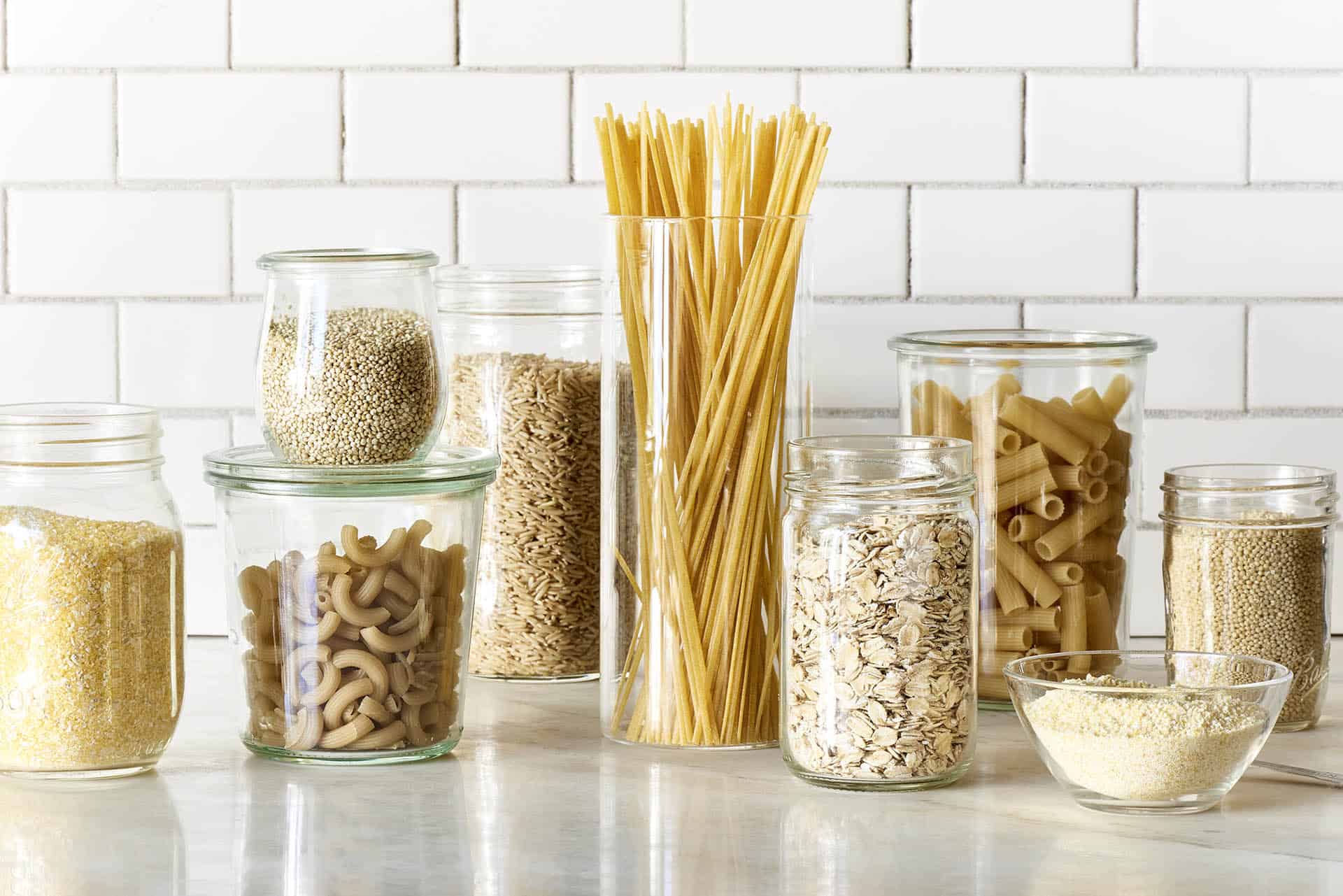
Gluten-Free Pasta
There are some sensational commercial gluten free pastas on the market that have a fantastic texture and flavor that continues to improve and as the demand for gluten-free pasta increases.
You can get spaghetti, linguini, penne, and spiral varieties, as well as lasagna sheets and cannelloni tubes. Most companies use blends containing rice, corn, quinoa, buckwheat, or amaranth.
For allergy-free pasta: Organ has pastas that are made from rice, corn and buckwheat, and are free of wheat, gluten, yeast, dairy, eggs, and nuts.
Brown Rice Pastas: I prefer the Tinkyada or Trader Joe’s brown rice pasta in the United States. I find that they most closely resemble their durum wheat counterparts.
Quinoa Pasta: I like the Ancient Harvest quinoa pastas.
For soba noodles: Make sure you read the labels on buckwheat noodles, as most of them are only part buckwheat, and the rest regular wheat. There are a few brands of fantastic 100% buckwheat soba noodles. Just follow the cooking directions and soak them in cold water after cooking to avoid a huge gluggy mess.
Ramen Noodles: Use Thai thick-style rice noodles widely available at health food stores, grocers, and online retailers. Just read the label carefully, and make sure they are 100% rice.
Low Carb Options:
Kelp Noodles – these are mineral-rich and slightly crunchy. Soak them in filtered water, and use in salads or with sauces for pasta dishes.
Spiralize zucchini, beets, carrots, sweet potato, jicama, and other vegetables .
To Cook Gluten-Free Pasta
To cook, bring salted water to the boil and add in some olive oil to prevent sticking. Be sure to follow the cooking instructions on the packet, as it is really easy to overcook gluten-free pastas, and they get gluggy very easily as they release their starches, making the texture really unpalatable.
Cook until just al dente, and rinse under cold water. Wheat pasta aficonados will tell you to never rinse pasta. But I find that it removes the intense starchy quality and makes them easier to work with.


